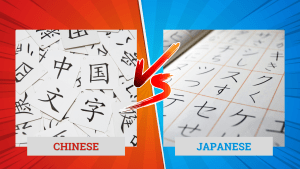At some point, you must have thought, “Chinese sounds so complex!” You’re absolutely right… and also not quite. Most people think of “Chinese” as one language; here’s where they get it wrong. It’s a diverse language family with over 130 languages spoken across China. At the heart of the confusion are Mandarin and Cantonese, the two most widely spoken Chinese languages.
They share the same ancient roots. They use many of the same characters. But once you hear them side by side? You’ll realise they’re worlds apart.
In this guide, we’ll break down the key differences between Mandarin and Cantonese, help you determine which one is right for you, and make the whole thing feel a lot less intimidating, whether you’re learning, localising, or just curious.
Quick Overview: Mandarin vs. Cantonese
| Feature | Mandarin (普通话 – Pǔtōnghuà) | Cantonese (廣東話 – Gwóngdūngwá) |
| Primary Status | Official language of Mainland China, Taiwan and Singapore | Co-official language in Hong Kong & Macau |
| Main Regions | Mainland China (esp. North/Southwest), Taiwan, Singapore | Guangdong Province, Hong Kong, Macau, Diaspora communities |
| Tones | 4 main tones + 1 neutral tone | 6 to 9 tones (commonly 6) |
| Native Speakers | Approx. 1.1 Billion+ | Approx. 85 Million |
| Romanisation | Hanyu Pinyin (standardised) | Various (Jyutping, Yale, etc. – less standardised) |
| Written Form | Standard Written Chinese using Simplified characters, Traditional (Taiwan) | Traditional, with unique Cantonese characters |
| Learning Curve | Easier due to standardisation | More complex due to tonal variety and colloquialisms |
| Global Use | Widely used in education, media, and diplomacy | Common in Cantonese-speaking diaspora communities |
6 Key Differences Between Mandarin and Cantonese
Though they share ancient roots, think of Mandarin and Cantonese today as distinct branches on the Chinese language tree. They’ve grown apart in fascinating ways. Here are six core areas where they diverge:
1. Pronunciation and Tones
This is the most immediate and striking difference. Both are tonal languages, meaning the pitch of your voice changes a word’s meaning entirely. But how they do it is vastly different.
Mandarin has four tones, which can be thought of as four ways to pronounce the same syllable with different pitch patterns. These tones are:
- Steady (mā – 妈, mother)
- Rising (má – 麻, hemp)
- Falling rising (mǎ – 马, horse)
- Falling (mà – 骂, scold)
There is also a neutral tone often used for grammatical particles or unstressed syllables, bringing the total to five.
Cantonese, on the other hand, has six primary tones, while some dialects have as many as nine. A tonal jungle, in fact. Hence, one syllable could have a pronunciation in all six manners, and each of them will change its meaning almost entirely.
- High level (si1 – 詩, poem)
- High rising (si2 – 史, history)
- Middle level (si3 – 試, to try)
- Low falling (si4 – 時, time)
- Low rising (si5 – 市, market)
- Low level (si6 – 事, matter)
This makes listening comprehension and speaking accuracy particularly difficult for beginners.
2. Vocabulary
Cantonese and Mandarin may share written similarities, but their spoken vocabulary and everyday phrases differ. Mandarin underwent heavy standardisation, resulting in regional consistency and relative ease of teaching.
Conversely, many classical and regional expressions remain alive in Cantonese, which are colourful yet more difficult for a beginner familiar with the everyday language.
For example, “thank you” in Mandarin is 谢谢 (xièxie), while in Cantonese, you’d say 唔該 (m̀h’gōi) when someone helps you or 多謝 (dōjeh) when receiving a gift. Even basic words can be quite different. “To eat” becomes 吃 (chī) in Mandarin but 食 (sihk) in Cantonese. These are not just accent differences, but they’re also different words.
| English | Mandarin | Cantonese |
| Not / No | 不 (bù) | 唔 (m4) |
| Drink | 喝 (hē) | 饮 (jam2) |
| Eat | 吃 (chī) | 食 (sik6) |
| Stand | 站 (zhàn) | 企 (kei5) |
| Who | 谁 (shuí) | 邊個 (bin1 go3) |
| What | 什么 (shénme) | 乜嘢 (mat1 je5) |
| Why | 为什么 (wèishénme) | 點解 (dim2 gaai2) |
3. Grammar
Compared to English, the Chinese grammatical style is surprisingly simple. It has no verb conjugations, the plurals, or the nouns, consequently without concern for gender. This gets trickier with the use of its sentence-final particles, mostly when referring to Cantonese. These are small words added to the end of a sentence to convey emotion or identity through intensity or subtlety.
Consider the phrase, “I know.” In Mandarin, it’s simply 我知道 (wǒ zhīdào) – short and straightforward. It’s suitable for both formal and casual use in Mandarin and doesn’t carry any emotional nuance unless it’s implied in context.
In Cantonese, you’d say 我知啊 (ngo5 zi1 aa3). The final particle “啊” softens the tone, making it sound like “Yeah, I know” or “Of course I know.” These subtle shifts add personality and warmth to everyday speech but also increase the learning curve.
4. Writing System
People often stumble in this part; So, let’s make it easy. Both Mandarin speakers and Cantonese speakers’ preferred medium for formal writing is the same system of Chinese characters, but when it comes to practical use, simplified characters are selected.
On the other hand, Cantonese generally opts for traditional characters that use special characters to represent words that are commonly spoken but rarely used in formal writing.
Take the idea of “not having” something: in Mandarin, one says “没有” (méiyǒu), which is formed from “没” (méi, meaning “not”) and “有” (yǒu, meaning “have”). In Cantonese, it is “冇” (mou5), a single character that means “not have.” Thus, where a Mandarin speaker might say “我没有钱” (I don’t have money), a Cantonese speaker would say “我冇錢.” A perfect example of how the two Chinese languages express similar ideas differently.
5. Geographic Reach & Global Influence
Mandarin is the language of choice for much of the official business; you will hear it in schools, on news broadcasts, in government offices, and in international situations. It is widely spoken in China and Singapore. Cantonese, however, is the language of preference and the heartbeat of Hong Kong pop culture, from music to TV shows to street slang.
It is globally spoken throughout Chinese communities in places such as the U.S., Canada, the U.K., and parts of Southeast Asia. Old Cantonese films, songs, and conversations among older generations who learned it during their childhood are a few of its other common uses.
6. Learning Curve
This one’s a classic question: “Is Mandarin easier to learn than Cantonese?”
In most cases, yes.
Mandarin generally takes fewer hours to achieve conversational fluency. Resources, teachers, apps, and support for Mandarin learners are everywhere. Cantonese has fewer structured learning resources and a steeper entry curve, mainly due to its tonal complexity and regional usage.
According to the U.S. Foreign Service Institute, it takes roughly:
- 2,200 hours for an English speaker to become fluent in Mandarin
- Even longer for Cantonese, due to its tonal complexity and lack of standard textbooks
But that doesn’t mean you need to reach fluency to get results. Conversational Mandarin is achievable in under a year with consistent effort, and basic Cantonese is also doable for travel or customer interactions.
Learners often describe Cantonese as more engaging once they get the hang of it, thanks to its rhythm, wit, and cultural references.
Which One Should You Choose?
Mandarin’s consistency and widespread use have made it the language of choice for learners, teachers, and corporations in Greater China and beyond that seek standardised communication. It is the language of academia, business, diplomacy, and modern media; ideal for those looking to expand their outreach to a broader and more scalable level.
Cantonese, on the other hand, presents great depth of culture rooted in tradition, expression, and local flavour. With its vivid colloquialisms, unique tonal rhythms, and emotional nuance, it’s especially valuable for those working in Hong Kong media, regional marketing, entertainment, or storytelling. If you’re localising for a Hong Kong audience, using Traditional Chinese with a spoken Cantonese style is essential.
So, at a glance:
| Your Scenario | Recommended Language |
| Expanding your startup into China, diplomacy, or academia? | Mandarin |
| Localising an app for Hong Kong | Cantonese |
| Learning Chinese for career advancement | Mandarin |
| Creating subtitles for C-dramas | Depends on the dialect used |
| Visiting Guangzhou | Cantonese |
| Launching e-learning courses in China | Mandarin |
| Marketing fashion products in Hong Kong | Cantonese |
| Planning to live in Beijing or Taipei? | Mandarin |
Choosing isn’t about which language is “better,” but which language is better for you.
Conclusion
Mandarin and Cantonese each offer a different window into Chinese culture, communication, and regional identity. Making an informed choice based on your specific goals – whether business, travel, or cultural connection – will help you engage more meaningfully in the incredibly diverse Chinese-speaking world.
Need Expert Chinese Language Services?
EC Innovations provides Mandarin and Cantonese translation and localization solutions. Whether you’re penetrating the mainland Chinese market or modifying your brand for audiences in Hong Kong, we deliver messages that are culturally and linguistically relevant.
Find out more about our Professional Chinese Translation Services tailored to fit your specific industry needs.
Ready to connect clearly? Contact us today to discuss your project.





